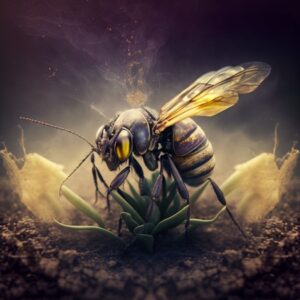
Blog

3T Vakil
Artist Rooted In The Rainforest
Related Posts



My Crazy Life

Artist’s Statement: “Spandrel Spaces: The Art of In-Between”
The disappearing act: global insect decline and our looming ecological catastrophe

News from our rainforest mountain biome in southeast Puerto Rico.
As an inhabitant of Puerto Rico’s lush rainforest for the last twenty-two years, I am witnessing a devastating phenomenon firsthand – the severe decline of insect populations in our forest. I have not done a scientific study on this, but I live here. I feel impelled to alert the world, as many others already are, to the harsh reality that the decreasing numbers of these tiny creatures pose an existential threat to our planet. Studies conducted over the past few decades unequivocally demonstrate that insect populations are plummeting globally. This alarming trend endangers not only the health of our ecosystems but also the stability of our food supply, and ultimately, our very existence as human beings. I feel it is urgent to delve into the causes of this catastrophic decline in insect populations and the grave consequences that it will bring and offer some solutions to prevent this ecological crisis from escalating further.
Despite the crucial role that insects play in sustaining our environment, they face a daunting enemy – humans who squeal in ignorance and fear. Phobias, hate, and general disdain for bugs are so widespread in our society that any conservation efforts are seriously hindered. It is high time that we take this matter seriously and act decisively to prevent the disastrous consequences of insect decline. As a concerned citizen, I implore you to join me in spreading awareness about this critical issue and advocating for effective measures to protect the insect world. Our survival as a species depends on it.
Causes of insect decline. Several factors, many of which are caused by humans, are causing insect populations to decline at an alarming rate. These elements include invasive species, pesticide use, habitat loss, and climate change.
- Loss of habitat. Loss of habitat is a major factor in the decline of insects. Natural ecosystems are being lost as human populations rise to make room for agriculture, urbanization, and infrastructural development. Insect population drops because of the loss of different habitats that provide insects with food and places to breed.
- Use of pesticides. The extensive use of pesticides is another important factor causing an insect reduction. These substances are meant to protect crops from pests, but they frequently have unwanted side effects that include killing important insects like pollinators and pest-predators that aren’t intended targets.
- Climate change. A significant contributor to the loss of insect populations is climate change. By modifying their habitats, upsetting their life cycles, and putting them under physiological stress, rising temperatures, harsh weather, and changing precipitation patterns can all have a negative effect on insects.
- Invasive species. The introduction of invasive species may cause native insect populations to diminish. Invasive species frequently outcompete native species for resources or prey on them directly, upsetting ecosystems and contributing to the loss of insects.
Impacts of the decline in insects. It has far-reaching effects on ecosystems and human culture when insect populations drop. Ecosystems can be harmed, the world’s food supply is threatened, and economic losses can arise from the loss of insects.
- A Ecosystem disruption By performing crucial tasks including pollination, nutrient cycling, and acting as a food source for other species, insects play a crucial role in ecosystems. Since the loss of these services might have a domino effect on other animals, the reduction of insects has the potential to cause ecosystems to collapse.
B Risk to the world’s food security. The reproduction of over 75% of the world’s crop species depends on pollinators like bees, butterflies, and beetles, which are essential for maintaining global food security. Crop yields would be much lower without these pollinators, resulting in food shortages and higher food prices.
C Economic losses The loss of insects has repercussions on the economy in addition to having a direct influence on food security. The absence of pollination services may result in lower agricultural yields and a greater reliance on expensive artificial pollination techniques. The decline of predatory insects as a natural form of pest control may lead to an increase in the use of pesticides. This shift towards pesticides can result in significant negative impacts on the environment and human health.
Action on several fronts must be taken right away to address the insect decline problem. The root reasons of decline, such as habitat restoration, sustainable agriculture methods, climate change mitigation, and invasive species management, must be the focus of any solutions.
- Habitat restoration. Restoring habitat is one of the most efficient strategies to fight insect reduction. Creating and protecting diverse habitats can provide insects with the necessary resources for their survival. Incorporating habitat corridors would improve connection between fragmented habitats while also conserving and restoring habitats like natural forests, wetlands, and grasslands.
- Sustainable agricultural practices. Adopting sustainable agricultural techniques can drastically lessen the impact of agriculture on insect populations. These practices include minimizing pesticide use by adopting integrated pest management strategies, planting cover crops, and creating field margins and hedgerows to provide habitat for beneficial insects. Additionally, supporting the use of organic farming methods, which eliminate industrial pesticides and fertilizers, can further assist safeguard insect populations.
- Climate change mitigation Through worldwide efforts to cut greenhouse gas emissions and constrict temperature increases, insect-related implications of climate change must be addressed. In order to combat climate change, it is imperative to promote the use of renewable energy sources, increase energy efficiency, and put sustainable land-use policies into place. Ecosystems like wetlands and forests can better act as carbon sinks through preservation and restoration, lowering the overall level of greenhouse gases in the atmosphere.
- Invasive species management In order to safeguard native insect populations, it is imperative that invasive species are effectively controlled. Preventative measures include early detection strategies, and quick reaction plans. It is crucial to educate the public on the dangers posed by invasive species. By implementing these strategies, we can better protect our native insect populations from the detrimental effects of invasive species.
- Research and monitoring To comprehend the severity and reasons of insect loss and to assess the success of conservation initiatives, ongoing research and monitoring of insect populations are crucial. Long-term monitoring programs can offer insightful information on population patterns, and focused study can assist pinpoint the precise causes of population decline and guide management tactics. It is essential for researchers, policymakers, and land managers to work together more closely to ensure that study findings are turned into practical conservation measures.

- Public outreach and education. Public outreach and education programs can help spread the word about the value of insects and the dangers they face, cultivating a sense of stewardship and spurring constructive action. Targeting schools, community organizations, and the general public with educational programs that emphasize the importance of protecting insects while also highlighting the ecological and economic significance of insects. Supporting citizen science activities can also assist involve the public in insect population monitoring and conservation.
- Policy and legislation This involves putting rules into place that encourage habitat preservation, control the use of pesticides, and encourage sustainable agricultural methods. Insect conservation can also be incorporated into broader biodiversity and climate change policies, ensuring that they are considered in attempts to manage the environment as a whole.
- Cooperation on a global scale. International collaboration is essential in resolving this issue given the worldwide scope of insect decrease. Collaboration across nations can make it easier to share best practices, resources, and expertise, which will help conservation efforts be more successful. Participation in global agreements, like the Convention on Biological Diversity, can encourage concerted action to save insect populations and the ecosystems they support.
NOW: To stop additional insect declines and lessen the effects on world food security, economies, and ecosystem health, it is vital to address the key drivers of this, which include habitat loss, pesticide use, climate change, and invasive species.Invasive species management, habitat restoration, sustainable farming methods, climate change mitigation, research and monitoring, public outreach and education, policy and law, and international cooperation are just a few of the options available to deal with this challenge. However, the dedication and cooperation of governments, researchers, industry, and the general public in recognizing the significance of insects and taking decisive action to safeguard them will be crucial to the success of these initiatives.
The current trend of insect reduction serves as a stern warning about the detrimental impact of human activities on nature. We must take this warning seriously as a global community and act quickly to protect insect populations and the vital services they offer. If this isn’t done, not only will we lose these amazing species, but the delicate environmental balance that supports the health and wealth of our world will also be upset. Although the task at hand is difficult, it is not impossible. We can implement successful strategies to address the underlying causes of insect decline and encourage their recovery by cooperating across disciplines and borders. Dedication, creativity, and a willingness to confront the status quo are all necessary for this endeavor.
The destiny of insects, as well as that of humanity, is in jeopardy. To ensure that insects continue to thrive and maintain the complex web of life on Earth, it is our collective responsibility to rise to the challenge equipped with knowledge and tenacity. “Insects are the little things that run the world,” said famous biologist E.O. Wilson. Now it is our responsibility to make sure that these tiny creatures receive the desperately needed protection and assistance. They have long maintained the ecosystems that support us. Humanity’s future is intrinsically tied to that of insects; by protecting them, we also rescue ourselves.
PS: Quit being scared of bugs; they are not out to get you!
Sánchez-Bayo, F., & Wyckhuys, K. A. G. (2019). Worldwide decline of the entomofauna: A review of its drivers. Biological Conservation, 232, 8-27. https://doi.org/10.1016/j.biocon.2019.01.020
Hallmann, C. A., Sorg, M., Jongejans, E., Siepel, H., Hofland, N., Schwan, H., … & Goulson, D. (2017). More than 75 percent decline over 27 years in total flying insect biomass in protected areas. PLoS ONE, 12(10), e0185809. https://doi.org/10.1371/journal.pone.0185809
Lister, B. C., & Garcia, A. (2018). Climate-driven declines in arthropod abundance restructure a rainforest food web. Proceedings of the National Academy of Sciences, 115(44), E10397-E10406. https://doi.org/10.1073/pnas.1722477115
Cardoso, P., Barton, P. S., Birkhofer, K., Chichorro, F., Deacon, C., Fartmann, T., … & Samways, M. J. (2020). Scientists’ warning to humanity on insect extinctions. Biological Conservation, 242, 108426. https://doi.org/10.1016/j.biocon.2020.108426
Seibold, S., Gossner, M. M., Simons, N. K., Blüthgen, N., Müller, J., Ambarlı, D., … & Weisser, W. W. (2019). Arthropod decline in grasslands and forests is associated with landscape-level drivers. Nature, 574(7780), 671-674. https://doi.org/10.1038/s41586-019-1684-3
Images created in Midjourney by 3t Vakil
 |
 |
 |
 |

